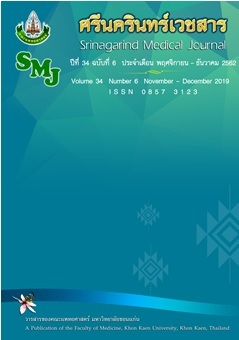Radiation Dose and Dose Distribution from Fluoroscopy: Phantom Study
Keywords:
dose distribution, fluoroscopy, radiation dosimeter, OSL, การกระจายรังสี, ฟลูออโรสโคปี, อุปกรณ์วัดปริมาณรังสี, โอเอสแอลAbstract
ปริมาณรังสีและการกระจายรังสีจากการตรวจด้วยเทคนิคฟลูออโรสโคปี: การศึกษาในเนื้อเยื่อจำลอง
ปนัสดา อวิคุณประเสริฐ1,2*, ธนาทิพย์ จันทร์แดง2, เขมิกา เกื้อพิทักษ์3, วิทิต ผึ่งกัน4, จิตติพร เขียนประสิทธิ์ 5
1ภาควิชารังสีวิทยา คณะแพทยศาสตร์วชิรพยาบาล มหาวิทยาลัยนวมินทราธิราช
2สาขาวิชาฟิสิกส์ คณะวิทยาศาสตร์ มหาวิทยาลัยขอนแก่น
3สาขาวิชารังสีวิทยา ศูนย์การแพทย์ปัญญานันทภิกขุชลประทาน มหาวิทยาลัยศรีนครินทรวิโรฒ
4กลุ่มมาตรฐานการวัดทางนิวเคลียร์และรังสี สำนักงานปรมาณูเพื่อสันติ
5 ภาควิชารังสีวิทยา คณะแพทยศาสตร์ มหาวิทยาลัยขอนแก่น
หลักการและวัตถุประสงค์: การทราบค่าปริมาณรังสีจะเป็นแนวทางป้องกันอันตรายให้กับผู้ป่วยและผู้ปฏิบัติงานได้ วัตถุประสงค์ของการศึกษานี้เพื่อหาค่าปรับแก้การตอบสนองต่อรังสีของอุปกรณ์วัดปริมาณรังสีชนิดโอเอสแอล (OSL) เพื่อวัดค่าปริมาณรังสีที่ผิวหนังจากการตรวจฟลูออโรสโคปี 4 เทคนิค คือ หลอดอาหาร (BS) ทางเดินอาหารส่วนบน (UGI) ลำไส้ใหญ่ (BE) และการตรวจปัสสาวะไหลย้อนกลับ (VCUG) และเพื่อสร้างแผนภูมิการกระจายปริมาณรังสีรอบเครื่อง
วิธีการศึกษา: ติด OSL บนเนื้อเยื่อจำลองและฉายรังสีที่พลังงานต่างๆ เพื่อหาค่าปรับแก้การตอบสนองต่อรังสี จากนั้น ติด OSL บนตำแหน่งของอวัยวะต่างๆ ของหุ่นเนื้อเยื่อจำลอง เพื่อวัดค่าปริมาณรังสีสมมูล และติด OSL บนเสาที่วางอยู่รอบเครื่องเพื่อวัดปริมาณรังสีกระเจิง
ผลการศึกษา: พลังงานและค่านับวัดมีความสัมพันธ์ตามสมการ y = 126531e-0.0151x ที่ช่องท้องพบปริมาณรังสีสูงสุด (18 mSv) จากเทคนิค BE และเต้านมได้รับปริมาณรังสี 8 mSv จากเทคนิค BS และ 17 mSv จากเทคนิค UGI สำหรับเทคนิค VCUG ทำให้มดลูกได้รับปริมาณรังสี 12 mSv และพบว่าการกระเจิงของรังสีมีค่าสูงที่บริเวณกลางเตียง
สรุป: การทราบค่าปริมาณรังสีที่ตำแหน่งอวัยวะที่ไวต่อรังสี เช่น เลนส์ตา ต่อมไทรอยด์ ช่วยให้ผู้ปฏิบัติงานตระหนักถึงอันตรายของรังสี เมื่อต้องปฏิบัติงานในบริเวณรังสี สามารถหลีกเลี่ยงตำแหน่งที่มีรังสีสูงๆ และใช้อุปกรณ์ป้องกันเพื่อลดปริมาณรังสี
Background and Objective: Knowing the level of radiation dose will be a radiation protection guideline for patients and staffs. The purposes of this study were to define a conversion factor for optically stimulated luminescence (OSL) dosimeters and to measure the skin equivalent dose from four fluoroscopic techniques; barium swallow (BS), upper GI (UGI), barium enema (BE) and voiding cystourethrography (VCUG). The charts of radiation dose distribution from fluoroscope were plotted.
Methods: OSL dosimeters were attached on the phantom and irradiated with different x-ray energies. The conversion factors were calculated. Then, OSL dosimeters were placed on the organs of Rando phantom to measure the radiation equivalent dose. Finally, OSL dosimeters were placed on the column surrounding the fluoroscope to measure the scattered radiation.
Results: The relationship between energy and count was follow the equation y = 126531e-0.0151x. The highest skin equivalent doses were at abdomen (18 mSv) from barium enema technique, breast received the radiation dose at 8 mSv from barium swallow examination and the radiation dose of 17 mSv from upper gastrointestinal study. The voiding cystourethrography produced the highest radiation dose to uterus at 12 mSv. Moreover, the highest scattered radiations were from the middle of couch.
Conclusions: Knowing the radiation dose at radiosensitive organs, such as eye lens and thyroids, help the staffs to aware of the danger of exposing to radiation. Radiation staffs can avoid the high radiation area and the use of radiation protection can reduce the radiation.
References
Rehani MM. Radiation-induced cataracts in staff engaged in interventional procedures. Physica Medica 2016; 32: 190.
Mahesh M. Fluoroscopy: patient radiation exposure issues. Radiographics 2001; 21: 1033-45.
Donadille L, Carinou E, Brodecki M, Domienik J, Jankowski J, Koukorava C, et al. Staff eye lens and extremity exposure in interventional cardiology: Results of the ORAMED project. Radiat Meas 2011; 46: 1203-09.
Khoury HJ, Garzon WJ, Andrade G, Lunelli N, Kramer R, de Barros VSM, et al. Radiation exposure to patients and medical staff in hepatic chemoembolisation interventional procedures in Recife, Brazil. Radiat Prot Dosimetry 2015; 165: 263-7.
Abbott A. Researchers pin down risks of low-dose radiation. Nature 2015; 523: 17-8.
Shamoun DY. Linear No-Threshold model and standards for protection against radiation. Regul Toxicol Pharm 2016; 77: 49-53.
Takegami K, Hayashi H, Nakagawa K, Okino H, Okazaki T, Kobayashi I, et al. Measurement method of an exposed dose using the nano Dot dosimeter. European Congress of Radiology; 4–8 March 2015; Austria Center Vienna, Vienna, Austria 2015.
Okazaki T, Hayashi H, Takegami K, Okino H, Nakagawa K. Evaluation of the angular dependence of the nanoDot OSL dosimeter toward direct measurement of the entrance skin dose. European Congress of Radiology; 4-8 March 2015; Austria Center Vienna, Vienna, Austria; 2015.
Kawaguchi A, Matsunaga Y, Suzuki S, Chida K. Energy dependence and angular dependence of an optically stimulated luminescence dosimeter in the mammography energy range. J Appl Clin Med Phys 2017; 18: 191-6.
Al Najjar A, Colosi D, Dauer LT, Prins R, Patchell G, Branets I, et al. Comparison of adult and child radiation equivalent doses from 2 dental cone-beam computed tomography units. Am J Orthod Dentofacial Orthop 2013; 143: 784-92.
Akyalcin S, English JD, Abramovitch KM, Rong XJ. Measurement of skin dose from cone-beam computed tomography imaging. Head Face Med 2013; 9: 9-28.
Yusof FH, Ung NM, Wong JHD, Jong WL, Ath V, Phua VCE, et al. On the Use of Optically Stimulated Luminescent Dosimeter for Surface Dose Measurement during Radiotherapy. PLoS One 2015; 10: e0128544.
Ding GX, Malcolm AW. An optically stimulated luminescence dosimeter for measuring patient exposure from imaging guidance procedures. Phys Med Biol 2013; 58: 5885-97.
Chaudhry R, Fox PJ, Dangle P, Abdalla W, Bradley H, Duranko M, et al. MP61-10 use of single point dosimeter to evaluate radiation dose with fluoroscopic voiding cystourethrogram in pediatric patients: A prospective pilot study. J Urol 2017; 197: e802-3.
Elona IA, Morales AA. Assessment of patient dose in selected non-cardiac interventional fluoroscopy procedures using osl dosimeters. In: Jaffray DA, editor. World Congress on Medical Physics and Biomedical Engineering; 7-12 June 2015; Toronto, Canada: Springer International Publishing; 2015: 783-6.
Gonzales CAB, Morales AA. Assessment of patient and staff doses in interventional cerebral angiography using OSL. In: Jaffray DA, editor. World Congress on Medical Physics and Biomedical Engineering; 7-12 June 2015; Toronto, Canada: Springer International Publishing; 2015: 778-82.
LANDAUER. nanoDotTM Dosimeter: Patient monitoring solutions 2017 [cited 2018 Feburary 9]. Available from: https://www.landauer.com/sites/default/files/product-specification-file/nanoDot_0.pdf.
Alejo L, Koren C, Ferrer C, Corredoira E, Serrada A. Estimation of eye lens doses received by pediatric interventional cardiologists. Appl Radiat Isot 2015; 103: 43-7.
Chiang HW, Liu YL, Chen TR, Chen CL, Chiang HJ, Chao SY. Scattered radiation doses absorbed by technicians at different distances from X-ray exposure: Experiments on prosthesis. Biomed Mater Eng 2015; 26 (Suppl 1): S1641-50.
Lesyuk O, Sousa PE, Rodrigues SI, Abrantes AF, de Almeida RP, Pinheiro JP, et al. Study of scattered radiation during fluoroscopy in hip surgery. Radiol Bras 2016; 49: 234-40.
Singer G. Occupational radiation exposure to the surgeon. The Journal of the American Academy of Orthopaedic Surgeons 2005; 13: 69-76.


